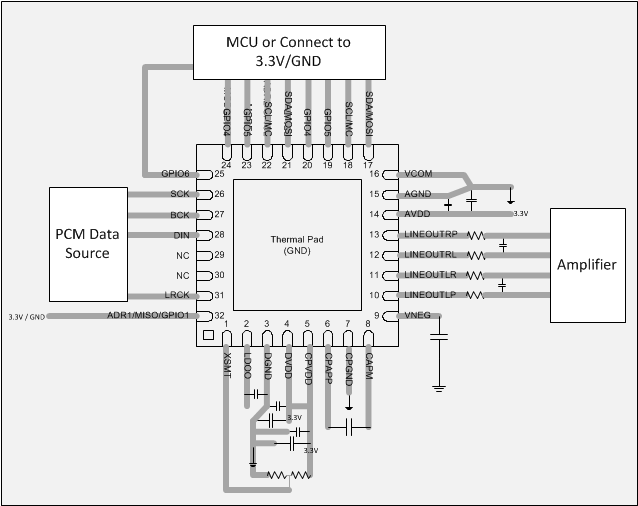ZHCSDH3 November 2014 PCM5252
PRODUCTION DATA.
- 1 特性
- 2 应用
- 3 说明
- 4 修订历史记录
- 5 Device Comparison
- 6 Pin Configuration and Functions
-
7 Specifications
- 7.1 Absolute Maximum Ratings
- 7.2 ESD Ratings
- 7.3 Recommended Operating Conditions
- 7.4 Thermal Information
- 7.5 Electrical Characteristics
- 7.6 Switching Characteristics
- 7.7 Timing Requirements: SCK Input
- 7.8 Timing Requirements: PCM Audio Data
- 7.9 Timing Requirements: I2S Master, See
- 7.10 Timing Requirements: XSMT
- 7.11 Typical Characteristics
-
8 Detailed Description
- 8.1 Overview
- 8.2 Functional Block Diagram
- 8.3
Feature Description
- 8.3.1 Terminology
- 8.3.2 Audio Data Interface
- 8.3.3 XSMT Pin (Soft Mute / Soft Un-Mute)
- 8.3.4 Audio Processing
- 8.3.5 DAC and Differential Analog Outputs
- 8.3.6
Reset and System Clock Functions
- 8.3.6.1 Clocking Overview
- 8.3.6.2 Clock Slave Mode With Master and System Clock (SCK) Input (4 Wire I2S)
- 8.3.6.3 Clock Slave Mode With BCK PLL to Generate Internal Clocks (3-Wire PCM)
- 8.3.6.4 Clock Generation Using the PLL
- 8.3.6.5 PLL Calculation
- 8.3.6.6 Clock Master Mode from Audio Rate Master Clock
- 8.3.6.7 Clock Master from a Non-Audio Rate Master Clock
- 8.4 Device Functional Modes
- 9 Application and Implementation
- 10Power Supply Recommendations
- 11Layout
- 12Programming
- 13Register Maps
- 14器件和文档支持
- 15机械、封装和可订购信息
11 Layout
11.1 Layout Guidelines
- The PCM5252 family of devices are simple to layout. Most engineers use a shared common ground for an entire device. GND can consider AGND and DGND connected.
- Good system partitioning should keep digital clock and interface traces away from the differential analog outputs for highest analog performance. This reduces any high-speed clock return currents influencing the analog outputs.
- Power supply and charge pump decoupling capacitors should be placed as close as possible to the device.
- The thermal pad on the underside of the package should be connected to GND.
- The top layer should be used for routing signals, whilst the bottom layer can be used for GND.
11.2 Layout Example
 Figure 83. PCM5252 Layout Example
Figure 83. PCM5252 Layout Example